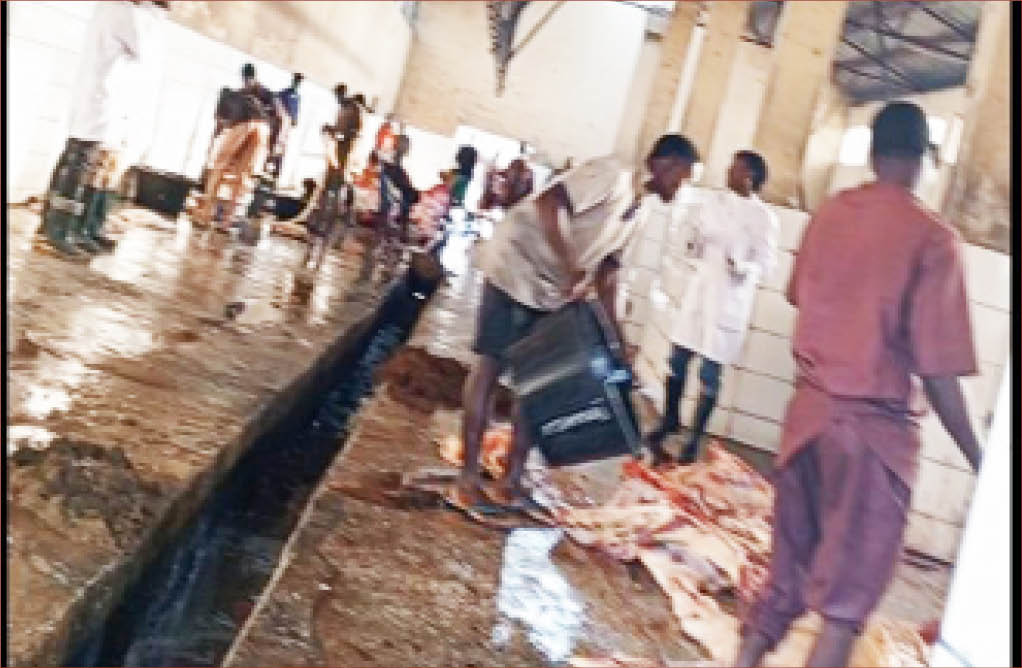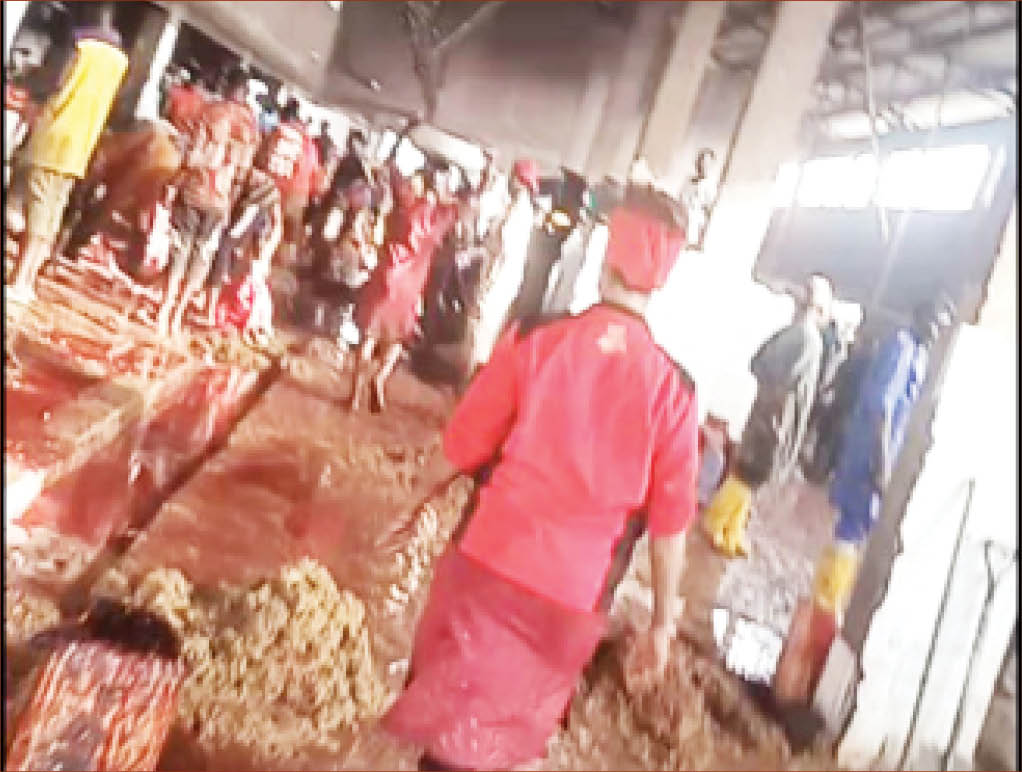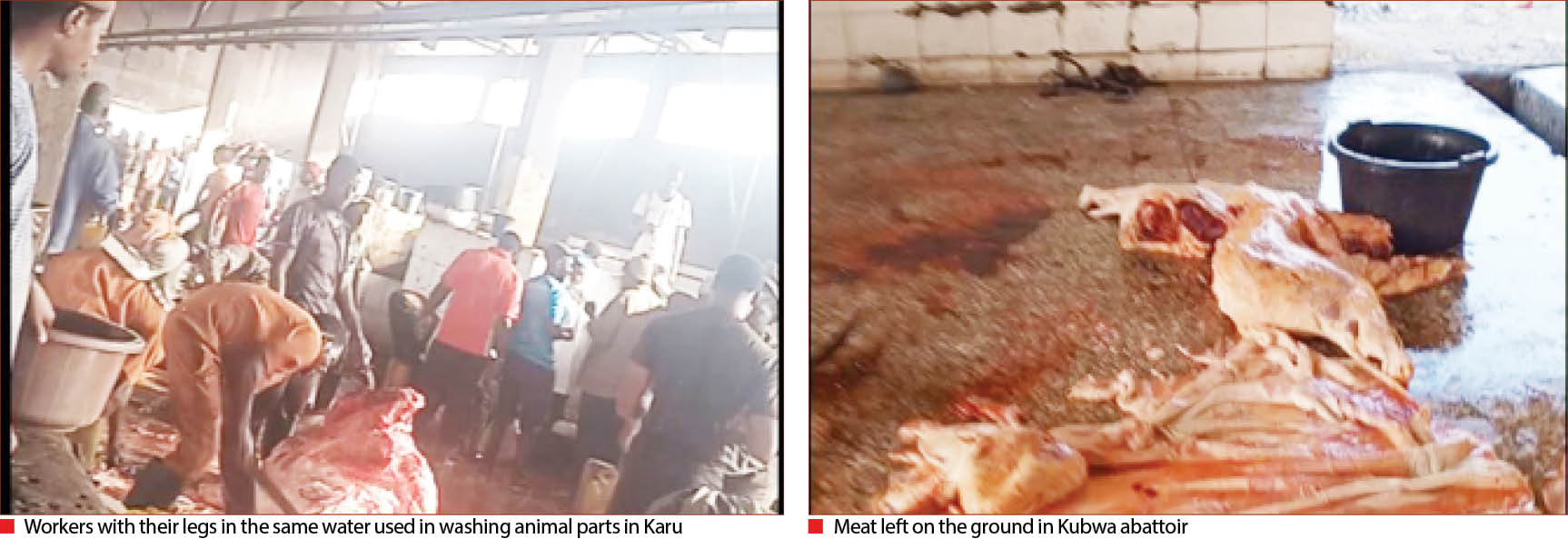INVESTIGATION: Gory tales from FCT abattoirs
The sight of thick, dark plumes rising into the sky like a funeral pyre signaled the exact location this reporter was heading to: the Karu abattoir in Nigeria’s Federal Capital Territory (FCT), where a grimy and suffocating stench of blood, intertwined with animal dung, hung heavy. Amidst this nauseating cloak that is impossible to ignore, […]

kubwa abattoir
The sight of thick, dark plumes rising into the sky like a funeral pyre signaled the exact location this reporter was heading to: the Karu abattoir in Nigeria’s Federal Capital Territory (FCT), where a grimy and suffocating stench of blood, intertwined with animal dung, hung heavy.
Amidst this nauseating cloak that is impossible to ignore, the abattoir was stuffed with workers, toiling with machetes and knives in blood and dung.
At 8am on a Thursday in January, slaughtering and butchering activities had begun when this reporter visited Karu. Fresh cow dung and blood were littered on the slaughter floor, and a butcher, dressed in an orange-colored uniform, trampled his dirty rain-boot on the meat as he consistently used his machete to work on it.
After witnessing at least six cows slaughtered, and despite sighting two vets stationed at the abattoir, no postmortem inspection was observed. Soon after the slaughter, the cows were fully dismembered and parts removed from the slaughter floor without inspection.
Hajj: 50 percent of seats allocated to FCT paid for
NSCDC summons senior officers over insecurity in FCT
This action is contrary to the globally recognised operational norms for best practices in meat inspection as established by the World Organisation for Animal Health and the Food Agriculture Organisation (FAO).

The FAO’s manual stipulates that meat inspection ensures that only healthy, physiologically normal animals are slaughtered for human consumption, while those found to be diseased or unfit are condemned or disposed accordingly. The manual stipulates routine postmortem examination of a carcass immediately after the dressing is completed – on the slaughter floor.
It explains that all organs and carcass portions must be kept together and correlated for inspection before they are removed from the slaughter floor. This, according to the manual, is to help in detecting any abnormalities by ensuring that only products fit for human consumption are passed as food. These stipulations of the FOA manual were, however, not carried out at the abattoir on the day of the visit.
With population growth in Nigeria on the rise, increase in the demand for meat consumption is equally rising. In 2021, Kneoma, a US-based data technology company, put the total meat production in the country at 1.47million tonnes, a significant increase from 387,522 tonnes in 1972.
In this investigation, Daily Trust Saturday visited Karu, Kubwa and Gwagwalada abattoirs, which are under the Department of Veterinary Services of the Federal Capital Territory Administration (FCTA), to observe the state of meat inspection.
Findings revealed that despite experts’ warnings that poor or ineffective meat inspection could be dangerous for consumers, our reporter observed an almost lack of inspection in some abattoirs around the FCT. This poses a significant public health hazard to consumers.
Meat and cow dung conveyed in same pan
In Karu, women were seen moving meat from the slaughter floor to tables. The women, dressed in green and maroon-colored uniforms, used head pans to convey the meat from the point of slaughter to the tables, where they are redressed by retailers and sold to consumers.
Daily Trust Saturday also observed that after transporting the meat, the women used the same head pans to pack the cow dung littered on the slaughter floor behind the slaughter house.
Published studies in the journal of veterinary science reveal that faecal materials, blood and animal hides, when in contact with meat during handling, can cause bacterial contamination, which could serve as a source of infection for consumers.
A 2019 research paper, published by Adeolu et al, titled Sanitary Status and Compliance with the Standard Slaughter Practices in Karu Abattoir Abuja Municipal Area Council of the FCT, Nigeria, in the International Journal of Current Innovations in Advanced Research found that subsequent animals slaughtered after the first ones were done on top of animal blood and dung due to non-careful and non-hygienic evisceration, which can result in cross-contamination of carcasses.
The paper also revealed that “ante/post-mortem examinations being carried out by health officers were not strict in applying some regulations like isolation, quarantine and elimination of suspected or diseased animals.”
A key finding of the research pointed out that “the regulations on the operations of the slaughterhouse were below the standard requirements and that much was needed to be done to improve the system at the facility.”
The situation had not changed at the time this reporter visited the Karu abattoir.
Despite inspections, meat poorly handled in Gwagwalada, Kubwa abattoirs
FAO’s manual on meat inspection for developing countries states that “the major sources of contamination are the animals, tools and equipment used in slaughter, workmen and the condition of the slaughterhouse environment.”
This means that aside meat inspection, meat handling is equally important. But in contrast, the situation of meat inspection in both Kubwa and Gwagwalada abattoirs was observed to be better than what was observed at Karu. The major concern observed by Daily Trust Saturday in both abattoirs was the issue of meat handling.
When Daily Trust Saturday visited Kubwa abattoir, which appeared as the neatest among the three on January 10, it was observed that meat inspection was strict. Four meat inspectors were seen within the slaughterhouse keeping a watch on the activities of the butchers.
One of the inspectors was seen conducting a postmortem inspection on the internal organs of a slaughtered cow, and an abattoir staff was sighted washing the parts that were already inspected while this reporter exchanged pleasantries with another.
However, Daily Trust Saturday observed lack of proper meat handling where an abattoir staff kept some parts of it, especially the internal organs, on the slaughter floor, which had blood and cow dung on it. This act, according to the FAO manual, could result in the contamination of carcasses, even after they have been inspected.
The situation was similar in Gwagwalada, where meat being inspected by veterinary officers, was poorly handled by abattoir staff. Chunks of meat were seen on the slaughter floor stained with blood and dung.
During the visit on January 12, a significant amount of meat was condemned by veterinary officers on duty. According to the vets, the cow lungs, spleens and other organs were suspected to have contagious bovine pleuropneumonia (CBPP), bovine tuberculosis (TB) and hydronephrosis.
Asked if any form of compensation was given to owners of meat being condemned, a credible source who doubles as a vet said, “Before now, there was compensation, but because it was being abused, it was stopped by the government.” 
Abattoirs still roast animal parts with scrap tyres
Upon entering Karu, a thick and dark smoke is noticed from the singeing area where goats and other hairy parts of slaughtered animals are roasted.
Behind the slaughterhouse lies this singeing area where goats and the hairy parts of slaughtered animals are singed. Daily Trust Saturday also observed that animal skins were roasted with tyres and washed in dirty water.
The pool-like area where the singed goats or hides are washed contains dirty water with faecal residues from the bowels of the animals. This reporter observed as workers dangled their legs in the pool of dirty water as they washed the meat in the same water.
While the use of scrap tyres was equally used to burn some animal parts at the Gwagwalada abattoir, a few workers were seen using firewood.
Singeing animals meant for consumption with tyre is harmful to both humans and the environment as it contains toxic material capable of causing serious health and environmental concern, said Dr Tessy Ahmadu, a radiation and clinical oncologist at the Federal Medical Centre, Jabi.
Dr Ahmadu noted that tyres contained toxic and heavy metal residues like carbon, zinc and sulphur, which are higher than permissible limits for humans, and when the residues are released from burning them, they cause contamination.
“When animals are roasted with burnt tyres, there is a risk of deposition of these heavy metals in the hides of these animals, which affects the quality of the meat and also bio-accumulate, leading to different effects on various organs of the final consumer.
“The smoke from burning tyres released into the environment also contains volatile carbon containing compounds, such that when released into the air, reduces air quality while some find their way into the soil and drinking water,” Dr Ahmadu said.
While noting that arsenic plays a role in the development of lung, bladder, skin, colon, gastric, kidney and nasopharyngeal cancer, the oncologist said the cancer-causing metal compounds could, among other things, result in increasing the risk of cancer and related diseases.
“Toxic materials like arsenic, cadmium, nickel and lead are introduced into the meat from sieging with scrap tyres. Most heavy metals are cancer-inducing agents and they exhibit an immense range of toxic effects on humans with regards to carcinogenesis.
“These heavy metals have been detected in an extensive variety of malignant growths and their accumulation over time, exceeding the acceptable limit could lead to kidney, urinary bladder, lung, liver, skin and gastric cancer,” she emphasized.
Vets not equipped with professional inspection kits – Source
In Gwagwalada, a source who asked for anonymity, hinted that veterinary officers, especially in the Gwagwalada abattoir, lacked ‘professional’ inspection kits, adding, “they only conduct physical examinations.”
He explained that some animals could physically look healthy, but without proper tests, could be carrying some diseases that may only be noticed after they have been slaughtered.
Daily Trust Saturday observed that vets within the FCT abattoirs visited only used their hands and knives to trim off infected parts where necessary during inspection of the carcasses or parts of the slaughtered animals.
However, Dr Sati Ngulukun of the National Veterinary Research Institute in Vom, Plateau State, said antemortem and postmortem inspections of animals, although they can be carried out through observation by experts, required certain equipment.
“During the antemortem inspection, of course equipment like a stethoscope is used to check the heartbeat of the animal and the thermometer to check the temperature. It is very important because when an animal has a very high fever, it may be an indication of a disease.
“Also, during the postmortem inspection, there are what we call postmortem kits, which contain all the materials like knives, forceps, and other materials that are used in examining the meat,” he noted.
In order to ensure that the meat is properly inspected, Dr Ngulukun added that every standard abattoir should have a laboratory attached to it because samples can be taken during both ante and postmortem inspections for impromptu diagnosis to confirm a problem or otherwise.
Incidentally, Daily Trust Saturday reports that none of the abattoirs visited has a functional laboratory where samples can be taken for diagnosis.
Neglecting meat inspection dangerous for consumers – Veterinary expert
The Director of the Diagnostic Services Department at the National Veterinary Research Institute in Vom, Plateau State, Dr Sati Ngulukun, explained that neglecting meat inspection could be dangerous for consumers due to the number of zoonotic diseases transmitted from animals to humans.
“When meat harbouring zoonotic diseases are not properly inspected and humans consume it, there’s a high chance that they may come down with those diseases.
“A very typical example is tuberculosis. When a cow is infected with tuberculosis and the meat is not properly inspected before consumption, people can get down with TB from eating that infected meat,” he emphasized.
He added that animals treated or injected with antibiotics before their withdrawal period should not be slaughtered. “If the animal is slaughtered during that period and people consume the meat, it will contain those drug residues that can cause drug resistance or reactions in humans,” he said.
Ngulukun described postmortem inspection as very important as it offers the possibility of further laboratory testing to ascertain what is being suspected.
“The meat or carcass will be briefly detained so that the laboratory test can be carried out to either approve or condemn the meat,” he noted.
Situation in abattoirs due to years of neglect – FCTA
Constitutionally, the responsibility for the establishment, maintenance, and regulation of slaughterhouses falls under the local government councils. In the FCT, the Department of Veterinary Services of the FCTA is responsible for ensuring that all meat intended for human consumption are wholesome right from the abattoirs, by ensuring meat inspection services in the abattoirs and slaughter slabs.
The department is also in charge of regulating the abattoirs in Gwagwalada, Kubwa and Karu.
Reacting to the neglect of meat inspection by inspectors and the unhygienic process witnessed in the abattoirs visited by Daily Trust Saturday, the Director, Department of Veterinary Services of the FCTA, Dr Idris Ademoh, said the department was aware of the general decay in the abattoirs. He attributed the situation to the age-long neglect and failure to upgrade and standardise the operations.
“This is caused by an operational system that is still conservatively traditional. But the focus of this administration is to carry out a comprehensive reform that will be based on holistic interventions to address and enforce measures within the Animal Diseases Control Act 2022,” he said.
This, according to him, “will be achieved through our immediate, medium and long-term action plans through an articulate policy on abattoir projects and operational standards in the FCT.”
“It will provide the platform for sensitive engagement with relevant stakeholders on transitioning from the current ways of doing things by embracing modernisation and ensuring that only wholesome meat is consumed in the FCT.”
